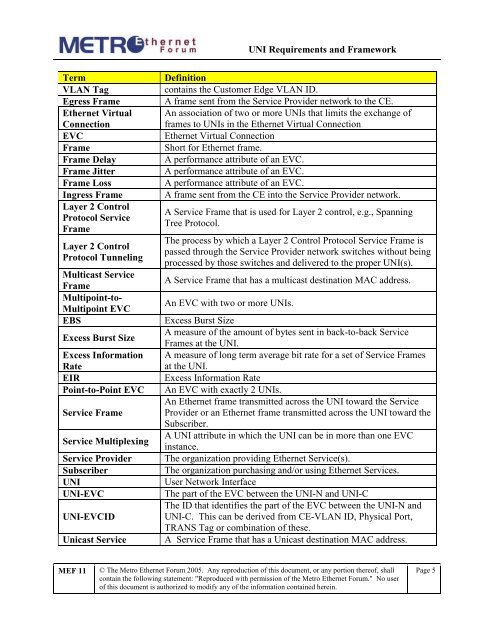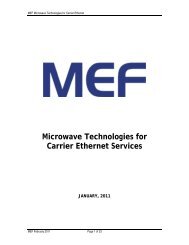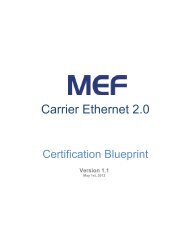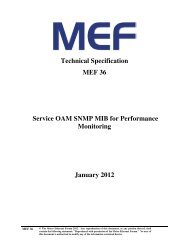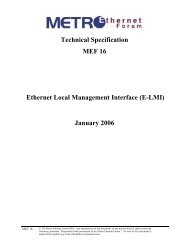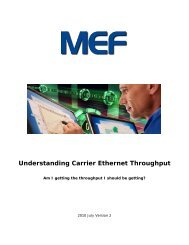User Network Interface (UNI) Requirements and Framework - MEF
User Network Interface (UNI) Requirements and Framework - MEF
User Network Interface (UNI) Requirements and Framework - MEF
Create successful ePaper yourself
Turn your PDF publications into a flip-book with our unique Google optimized e-Paper software.
<strong>UNI</strong> <strong>Requirements</strong> <strong>and</strong> <strong>Framework</strong><br />
Term<br />
VLAN Tag<br />
Egress Frame<br />
Ethernet Virtual<br />
Connection<br />
EVC<br />
Frame<br />
Frame Delay<br />
Frame Jitter<br />
Frame Loss<br />
Ingress Frame<br />
Layer 2 Control<br />
Protocol Service<br />
Frame<br />
Layer 2 Control<br />
Protocol Tunneling<br />
Multicast Service<br />
Frame<br />
Multipoint-to-<br />
Multipoint EVC<br />
EBS<br />
Excess Burst Size<br />
Excess Information<br />
Rate<br />
EIR<br />
Point-to-Point EVC<br />
Service Frame<br />
Service Multiplexing<br />
Service Provider<br />
Subscriber<br />
<strong>UNI</strong><br />
<strong>UNI</strong>-EVC<br />
<strong>UNI</strong>-EVCID<br />
Unicast Service<br />
Definition<br />
contains the Customer Edge VLAN ID.<br />
A frame sent from the Service Provider network to the CE.<br />
An association of two or more <strong>UNI</strong>s that limits the exchange of<br />
frames to <strong>UNI</strong>s in the Ethernet Virtual Connection<br />
Ethernet Virtual Connection<br />
Short for Ethernet frame.<br />
A performance attribute of an EVC.<br />
A performance attribute of an EVC.<br />
A performance attribute of an EVC.<br />
A frame sent from the CE into the Service Provider network.<br />
A Service Frame that is used for Layer 2 control, e.g., Spanning<br />
Tree Protocol.<br />
The process by which a Layer 2 Control Protocol Service Frame is<br />
passed through the Service Provider network switches without being<br />
processed by those switches <strong>and</strong> delivered to the proper <strong>UNI</strong>(s).<br />
A Service Frame that has a multicast destination MAC address.<br />
An EVC with two or more <strong>UNI</strong>s.<br />
Excess Burst Size<br />
A measure of the amount of bytes sent in back-to-back Service<br />
Frames at the <strong>UNI</strong>.<br />
A measure of long term average bit rate for a set of Service Frames<br />
at the <strong>UNI</strong>.<br />
Excess Information Rate<br />
An EVC with exactly 2 <strong>UNI</strong>s.<br />
An Ethernet frame transmitted across the <strong>UNI</strong> toward the Service<br />
Provider or an Ethernet frame transmitted across the <strong>UNI</strong> toward the<br />
Subscriber.<br />
A <strong>UNI</strong> attribute in which the <strong>UNI</strong> can be in more than one EVC<br />
instance.<br />
The organization providing Ethernet Service(s).<br />
The organization purchasing <strong>and</strong>/or using Ethernet Services.<br />
<strong>User</strong> <strong>Network</strong> <strong>Interface</strong><br />
The part of the EVC between the <strong>UNI</strong>-N <strong>and</strong> <strong>UNI</strong>-C<br />
The ID that identifies the part of the EVC between the <strong>UNI</strong>-N <strong>and</strong><br />
<strong>UNI</strong>-C. This can be derived from CE-VLAN ID, Physical Port,<br />
TRANS Tag or combination of these.<br />
A Service Frame that has a Unicast destination MAC address.<br />
<strong>MEF</strong> 11<br />
© The Metro Ethernet Forum 2005. Any reproduction of this document, or any portion thereof, shall<br />
contain the following statement: "Reproduced with permission of the Metro Ethernet Forum." No user<br />
of this document is authorized to modify any of the information contained herein.<br />
Page 5


